BACK PAGE |
Through the generosity of The Andrew W. Mellon Foundation, Kamehameha Schools, and the Kahiau Foundation, the Mellon-Hawai‘i Doctoral and Postdoctoral Fellowship Program was established at The Kohala Center in 2008. Twenty Native Hawaiian scholars have received fellowships through the program, supporting their scholarly work to advance knowledge about Hawaiian natural and cultural environments, Hawaiian history, politics, and society.
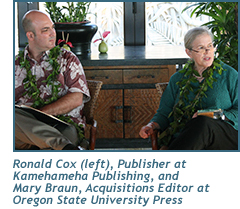 Induction Weekend for the fifth cohort kicked off with a tour of the Ke‘eku and Hapaiali‘i heiau in Kahalu‘u, led by Mahealani Pai. This year’s fellows then set off to finish their kīhei (Hawaiian cloaks) for the Induction ceremony that would take place at the end of the weekend.
Induction Weekend for the fifth cohort kicked off with a tour of the Ke‘eku and Hapaiali‘i heiau in Kahalu‘u, led by Mahealani Pai. This year’s fellows then set off to finish their kīhei (Hawaiian cloaks) for the Induction ceremony that would take place at the end of the weekend.
Fellows past and present then gathered for a panel discussion featuring three academic publishers: Mary Braun, Acquisitions Editor at Oregon State University Press; Niels Hooper, Executive Editor at University of California Press; and Ronald Cox, Publisher at Kamehameha Publishing. The panelists elaborated on the state of academic publishing today, and how emerging academics seeking to have their manuscripts published can stand out among the vast field of submissions publishers receive each year. This event presented the fellows with a coveted opportunity to ask questions of experts and network with prospective publishers.
“The intelligence, creativity, and rigor of the Fellows’ work are truly impressive,” said Braun. “I was inspired and energized by spending time with gifted and socially motivated intellectuals, in such a beautiful and welcoming environment.”
The following day, this year’s fellows gave presentations to approximately 50 program supporters, partners, and members of the community, highlighting the progress of their work since being accepted to the fellowship program. First was Doctoral Fellow Marie Alohalani Brown, a Ph.D. candidate in English at the University of Hawai‘i at Mānoa. Her dissertation, “Facing the Spears of Change: The Life and Legacy of John Papa ‘Ī‘ī,” chronicles the life and contributions of, as Brown put it, “an amazing Hawaiian intellectual whose life and legacy have been forgotten.” Brown explains, “When he was ten years old, ‘Ī‘ī became a kahu ali‘i (attendant or guardian to a high chief) to Liholiho (Kamehameha II). He went on to become an extremely influential statesman. ‘Ī‘ī’s place in Hawaiian history is often overlooked, and in many cases, inadequately documented, yet written records of his life and intellectual contributions are quite extensive.” What most people know about ‘Ī‘ī comes from Fragments of Hawaiian History, a heavily edited English-language recasting of ‘Ī‘ī’s life writings. Although Fragments purports to honor ‘Ī‘ī and his knowledge, it takes liberties with his voice and imposes a Western understanding of history. It displaces him as a remarkable Kanaka Maoli intellectual, othering him by relegating him to the role of native informant. Thus, Brown asserts, a reliance on Fragments as a sufficient representation of ‘Ī‘ī’s life does a great disservice to him. “‘Ī‘ī is an inspiring figure,” Brown said in concluding her presentation. “He dedicated his life to the Kamehameha family, his nation, and his people. He was a key player in the most important arenas of power for nearly sixty years. Yet, in spite of his impressive service record, very few people today have even heard of him, or if they have, are unaware of the extent of his legacy. I hope to rectify this situation.”
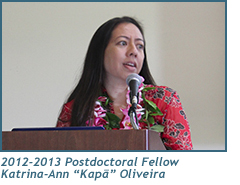 Following Brown was Postdoctoral Fellow Katrina-Ann Rose-Marie Kapā‘anaokalāokeola “Kapā” Nakoa Oliveira, who earned her Ph.D. in geography from the University of Hawai‘i at Mānoa in 2006. As a Postdoctoral Fellow, Oliveira was accepted to the Mellon program so she could focus on completing her manuscript, “Naming Maui: Mai Kekahi Kapa a Kekahi Kapa Aku,” which chronicles the importance of place and street names on the island of Maui to Hawaiian history, including the impacts of the Hawaiian monarchy era and colonization on naming practices. “As a budding geographer and a Hawaiian language scholar, my research interests this year in particular are my kulāiwi (ancestral places),” said Oliveira. “My work is informed by my kūpuna (respected elders) and the ancestral homelands of my lineage. Everything I do is a marriage of Hawaiian language and geography. One day I was driving around and noticing street signs, and I thought to myself, ‘Hey, I’m a geographer, why don’t I use the street signs as another vehicle to assist my students?’ These are signs we pass by all the time…why not use them as a way to tell and teach the history of a place? Who are all of these ali‘i we name our streets and thoroughfares after? And how are they related? These signs we see every day have tremendous history behind them, and my work seeks to bring that history forward.”
Following Brown was Postdoctoral Fellow Katrina-Ann Rose-Marie Kapā‘anaokalāokeola “Kapā” Nakoa Oliveira, who earned her Ph.D. in geography from the University of Hawai‘i at Mānoa in 2006. As a Postdoctoral Fellow, Oliveira was accepted to the Mellon program so she could focus on completing her manuscript, “Naming Maui: Mai Kekahi Kapa a Kekahi Kapa Aku,” which chronicles the importance of place and street names on the island of Maui to Hawaiian history, including the impacts of the Hawaiian monarchy era and colonization on naming practices. “As a budding geographer and a Hawaiian language scholar, my research interests this year in particular are my kulāiwi (ancestral places),” said Oliveira. “My work is informed by my kūpuna (respected elders) and the ancestral homelands of my lineage. Everything I do is a marriage of Hawaiian language and geography. One day I was driving around and noticing street signs, and I thought to myself, ‘Hey, I’m a geographer, why don’t I use the street signs as another vehicle to assist my students?’ These are signs we pass by all the time…why not use them as a way to tell and teach the history of a place? Who are all of these ali‘i we name our streets and thoroughfares after? And how are they related? These signs we see every day have tremendous history behind them, and my work seeks to bring that history forward.”
Wrapping up the presentations was Doctoral Fellow Kaipo Perez III, a Ph.D. candidate in zoology at the University of Hawai‘i at Mānoa who recently defended his dissertation “Integrating Traditional Ecological Knowledge with Science in Kahalu‘u Bay, Hawai‘i.” Perez’s research focuses on the impacts of tourism, development, and climate change on water quality and ecosystem health in Kahaluʻu Bay on Hawai‘i Island. His approach utilizes a Traditional Ecological Knowledge (TEK) model, which bridges Western scientific methods with cultural data gleaned from the region’s kūpuna.
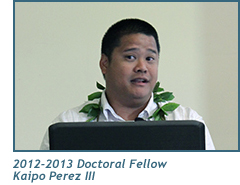 “It’s essential to capture cultural data from those who have deep roots in the ahupua‘a before it is lost forever,” notes Perez. “The breadth of TEK builds over time, and is more holistic and qualitative than traditional research methods, which are so data- and analysis-driven. TEK provides a more comprehensive landscape to understanding the bay’s history, challenges, and solutions, and ensures that our kūpuna and community are part of the solutions and have influence on positive outcomes.”
“It’s essential to capture cultural data from those who have deep roots in the ahupua‘a before it is lost forever,” notes Perez. “The breadth of TEK builds over time, and is more holistic and qualitative than traditional research methods, which are so data- and analysis-driven. TEK provides a more comprehensive landscape to understanding the bay’s history, challenges, and solutions, and ensures that our kūpuna and community are part of the solutions and have influence on positive outcomes.”
Perez elaborated on what makes his research and his approach to it unique. “I approach my work wearing two hats: my ‘science hat’ and my ‘culture hat.’ The ‘science’ is what you would expect: quantitative research, data gathering and the like. But the ‘culture’ aspect is absent in many scientific endeavors. Before I began this project, I felt it was important to forge and maintain intimate relationships with the community, managers, policymakers and key players within the Kahaluʻu Bay area. And before we did any studies or monitoring, we met with people, from kūpuna all the way down to keiki (children), to discuss what we wanted to do there and gather their input, what they wanted to know about the bay, and what adjustments they wanted to see. Because when you come into an area like this and do research, even when you know the answer is ‘yes,’ you still need to ask for permission and make sure that what you’re doing there is beneficial to the people. I approach my scientific work as a servant to the community.”
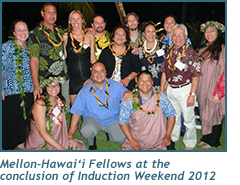 The Induction Weekend concluded with a ceremony and celebration, bringing together Kohala Center staff, senior Advisory Board members, fellows, and mentors. This year’s fellows and mentors were introduced by Robert Lindsey, Jr., Kohala Center Board Member and Office of Hawaiian Affairs Trustee, and congratulatory remarks delivered by 2008-2009 Mellon-Hawai‘i Postdoctoral Fellow Dr. B. Kamanamaikalani Beamer. “I was moved by the rigor of your analyses, the heart and amount of mana (energy) that you have invested in your scholarship,” Beamer told the fellows. “Your presentations were truly moving and inspirational, and your work continues to make me proud to not only be an academic, but to be a kanaka. I promise you this year will be amazing, you will be supported in ways you’ve probably never imagined or experienced before, and the networks and the people you will meet will forever change your trajectory as an academic.”
The Induction Weekend concluded with a ceremony and celebration, bringing together Kohala Center staff, senior Advisory Board members, fellows, and mentors. This year’s fellows and mentors were introduced by Robert Lindsey, Jr., Kohala Center Board Member and Office of Hawaiian Affairs Trustee, and congratulatory remarks delivered by 2008-2009 Mellon-Hawai‘i Postdoctoral Fellow Dr. B. Kamanamaikalani Beamer. “I was moved by the rigor of your analyses, the heart and amount of mana (energy) that you have invested in your scholarship,” Beamer told the fellows. “Your presentations were truly moving and inspirational, and your work continues to make me proud to not only be an academic, but to be a kanaka. I promise you this year will be amazing, you will be supported in ways you’ve probably never imagined or experienced before, and the networks and the people you will meet will forever change your trajectory as an academic.”
The entirety of the weekend provided this year’s fellows and those who preceded them a great sense of community, support, and encouragement. The Mellon-Hawai‘i Fellows comprise a truly gifted group of emerging scholars dedicated to further our islands’ rich history and culture. “The induction weekend really brought everything home for me in so many ways,” Brown said. “I was, and am, overwhelmed by the honor and a sense of gratitude in knowing that the Board members and my colleagues find our work valuable and meaningful, that our work can bring about change, and inspire others. Their support empowers me even more than my own drive and as I continue my efforts to obtain my Ph.D. and contribute in meaningful ways to the Native Hawaiian community. Their support and experiences are of great comfort and inspiration.”
A positive step to reduce overfishing
Available as a beautifully designed and printed two-foot-by-three-foot poster, or as a downloadable PDF or JPEG image, the Spawning Guide provides scientific and cultural information to help protect marine species at vulnerable times in their life cycles, such as peak breeding seasons.
The idea for the Guide was “spawned” by Kona native Cindi Punihaole, Outreach and Volunteer Coordinator for The Kohala Center and Project Director at Kahalu‘u Bay Education Center (KBEC). While facilitating a sustainable fishing camp for youth and their families at Ka‘ūpūlehu on the Kona-Kohala coast, Punihaole imagined a comprehensive and visual way of sharing information about Hawai‘i’s ocean resources and how to protect fish species.
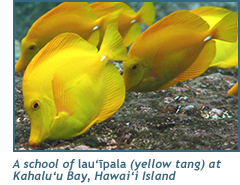 The first Guide was published in 2011, followed by a second edition in 2012 that features a total of 23 fish species, including ‘opihi. The Guide and its companion Web site, SpawningGuide.org, include a chart of Hawaiian lunar phases, as well as a list of “Pono Practices” such as self-restraint, reverence for ancestors and sacred places, and concern about future generations.
The first Guide was published in 2011, followed by a second edition in 2012 that features a total of 23 fish species, including ‘opihi. The Guide and its companion Web site, SpawningGuide.org, include a chart of Hawaiian lunar phases, as well as a list of “Pono Practices” such as self-restraint, reverence for ancestors and sacred places, and concern about future generations.
“We want to teach the community about the depletion of fish species and how to become more mindful about when to take and not to take from our ocean resources,” Punihaole said. “Both reef fish and pelagic fish need ‘breathing time’ to reproduce. The peak spawning months are the times that you want to be more respectful and not overfish. It’s about maintaining balance.”
Punihaole says local fishermen appreciate the Spawning Guide, as do children in schools who have been introduced to the program. Elegantly designed by artist Mele McPherson, the Guide doubles as a work of art that can be mounted or framed.
“We want to teach and encourage the local community to become its own enforcer,” Punihaole said. “We’d also like to see local chefs and restaurants incorporate some of the principles into their menu selections. It’s strictly a volunteer movement, but we have to start somewhere.”
The Spawning Guide is sponsored by National Oceanic and Atmospheric Administration (NOAA), the West Hawai‘i Fund of the Hawai‘i Community Foundation, and The Kohala Center.
Experts in the field came together to provide data for the Spawning Guide, including Dr. William Walsh, Ph.D., of Hawai‘i Department of Land and Natural Resources; Robert L. Humphreys, Jr., of NOAA; and Donald Kobayashi, Ph.D., of Pacific Islands Fisheries Science Center, NOAA/NMFS.
To obtain a copy of the Spawning Guide, call 808-640-1166 or e-mail kahaluubay@kohalacenter.org. Proceeds benefit KBEC’s ReefTeach program, which educates visitors to respect and mālama (take care of) our West Hawai‘i reefs.
Investigating “re-localization” on Moloka‘i and Hawai‘i Island
The Center has facilitated the research of a number of Yale’s industrial ecology graduate students who have studied how resources and energy are extracted from Hawai‘i’s natural environment, processed by industrial systems such as factories or in agriculture, and then consumed by people or expelled as waste products. At its heart, industrial ecology is interested in sustainable, closed-loop systems that do not rely on material exchanges from outside. The discipline borrows a metaphor from systems in natural environments, or the human body, to describe the metabolic processes of material flows—how resources move through and are utilized in the systems that fuel our daily lives.
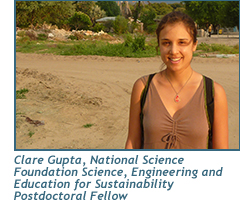 Over many years, Yale researchers working with The Kohala Center in forestry management and environmental science have examined options for dealing with resources and waste across the state. Studies led by Marian Chertow, an Associate Professor at Yale’s School of Forestry and Environmental Studies, have looked at waste disposal on O‘ahu, measured the flow of materials into and out of the Hawai‘i Island system, and documented human-nature interactions in Kailua-Kona and Hilo.
Over many years, Yale researchers working with The Kohala Center in forestry management and environmental science have examined options for dealing with resources and waste across the state. Studies led by Marian Chertow, an Associate Professor at Yale’s School of Forestry and Environmental Studies, have looked at waste disposal on O‘ahu, measured the flow of materials into and out of the Hawai‘i Island system, and documented human-nature interactions in Kailua-Kona and Hilo.
Gupta was inspired by The Kohala Center’s vision of positioning the Island of Hawai‘i as a place where innovative ideas and solutions for a sustainable future could be developed. She was also inspired by Professor Chertow’s research, which uses quantitative analysis to address environmental issues like resource constraints and waste disposal—problems that are heightened in an island setting Gupta’s own doctoral work in Botswana was focused on the social and economic contexts in which environmental problems are situated; she saw enormous potential in combining her training, The Kohala Center’s compelling vision, and Professor Chertow’s approach to industrial ecology. In collaboration with The Kohala Center and Yale, Gupta designed a postdoctoral project that investigates how local politics, policy, and culture influence the use and management of resources in island communities. “I am striving towards the ‘gold standard’ for community-engaged research that combines scholarly rigor and academic relevance with community needs and interests,” she said.
Gupta’s work focuses on “re-localization” on Moloka‘i and Hawai‘i Island. Re-localization efforts recreate the closed-loop systems of energy and resource production and consumption that have effectively sustained island ecosystems and communities. The National Science Foundation-funded research allows Gupta to maintain a dual appointment at Yale, advised by Professor Chertow, and be at The Kohala Center, engaged in research and functioning as a research liaison between Yale and Hawai‘i.
“Location matters a lot,” according to Gupta. “Yale’s School of Forestry and Environmental Studies is trying to make the work of its researchers relatable to the communities they work in. Getting to spend time between New Haven and Waimea means that I get to know people and build richer, stronger relationships” with local scientists and community members already engaged in sustainability work on their own islands.
Those relationships, in turn, challenge her to not only garner community support and input into her research, but to make the results relevant and accessible. “It’s very important to give back results,” she says. “We’re not working in an extractive model where the researcher learns something without giving back findings that are useable by the community.” In that respect, Gupta sees her team’s research and community work as part of an integrated system. The connection with The Kohala Center helps her to “stay grounded by making sure what we do is translatable and given to the community in digestible, accessible, user-friendly, and ultimately interesting ways.” The distribution of findings will entail school visits, mentoring undergraduate researchers, and engaging the community in making public policy.
The two-and-a-half-year-long project, begun in September 2012, may produce results that influence policy and planning—not just in Hawai‘i, but also far beyond. “The process of re-localizing will create changes for material flows into and out of the islands, including those that would change what we import and export,” Gupta believes. “Those changes will be influenced by social politics and public policies that need to be evaluated as well.” Examples of graduate projects that Gupta has helped develop include examining what would be necessary to revitalize the cattle industry on Moloka‘i, and gathering empirical evidence on the feasibility of growing crops for biofuels on Hawai‘i Island.
Through a close partnership with Yale University, The Kohala Center continues its commitment to engaging challenges at the intersection of human and natural systems by supporting researchers like Clare Gupta to find creative solutions, with island communities serving as positive models for the world.
Valerie Ossipoff joins Board of Directors
Born and raised in Honolulu, Valerie graduated from Punahou School before earning a bachelor’s degree from Wells College, a master’s in health and medical sciences from University of California, Berkeley, and a second master’s in clinical psychology from the Pacific Graduate School of Psychology in Palo Alto, California. She resided in the San Francisco Bay Area for 35 years, raising a family and building a career as a vocational rehabilitation counselor and a psychotherapist, before returning to Hawai‘i in 2000. She is the daughter of legendary Honolulu architect Vladimir Ossipoff.
“The organization really excites me,” Valerie says. “From its unique structure to its projects, philosophy, its raison d’être, The Center brings out the best in people by empowering them to be more self-sufficient and to help themselves, and each other. I find that extremely admirable.”
Valerie’s local roots and passionate commitment to supporting cultural and environmental endeavors make her an asset to our board. In addition to her philanthropic work with Honolulu arts organizations, Valerie also volunteered for the Nature Conservancy and Sierra Club in California, and sponsored two teenagers in the California Conservation Corps.
“We are very pleased that Valerie has accepted our invitation to join our Board,” said Roberta Fujimoto Chu, The Center’s Board President. “Her important experience in nonprofit management and her strong ties to cultural circles in Hawai‘i add an important dimension to our Board’s and staff’s outreach efforts.”
Please join us in welcoming Valerie to our ‘ohana.
School Learning Garden Symposium to be held in Waimea
“School Learning Gardens and Sustainability Education: Bringing Schools to Life and Life to Schools,” will be held June 7-8, 2013 in Waimea, Hawai‘i Island, at the Gates Performing Arts Center at Hawai‘i Preparatory Academy (HPA) and Māla‘ai: The Culinary Garden of Waimea Middle School.
 Friday kicks off with a keynote address by Dilafruz Williams, a professor of educational leadership and policy at Portland State University. Her address will be followed by 15 breakout sessions, as well as a Hawai‘i Farm to School and School Garden Hui panel discussion with representatives from each island. Friday evening will feature the West Hawai‘i premiere of the documentary Nā Kupu Mana‘olana - Seeds of Hope, Danny Miller’s new film on Hawai‘i’s agricultural history and promise.
Friday kicks off with a keynote address by Dilafruz Williams, a professor of educational leadership and policy at Portland State University. Her address will be followed by 15 breakout sessions, as well as a Hawai‘i Farm to School and School Garden Hui panel discussion with representatives from each island. Friday evening will feature the West Hawai‘i premiere of the documentary Nā Kupu Mana‘olana - Seeds of Hope, Danny Miller’s new film on Hawai‘i’s agricultural history and promise.
Saturday’s agenda includes a presentation by Pomai Bertelmann, followed by tours of up to six school gardens in the Waimea area, and concludes with a garden luncheon at Māla‘ai with Slow Food Hawai‘i.
Keynote Speaker Williams has studied the effects of ecological education on academic achievement and social skills acquisition for more than 20 years. She also served as chair of the board of the Council of the Great City Schools, comprising 66 of the nation’s largest school districts. Williams has distinguished herself in sustainability education, environmental education, learning gardens, garden-based education research, K-12 leadership and policy, diversity, social justice, service-learning, and community-university-school strategic partnerships. Williams will also be serving as a mentor for the second cohort of Kū ‘Āina Pā, a new school learning garden teacher training program for Hawai‘i’s teachers.
The first Kū ‘Āina Pā cohort will present their year-long action research projects at the symposium. The class of 26 teachers from Hawai‘i Island has been working individually and together to deepen their knowledge and skills in the art of teaching in school learning gardens. The cohort will present on subjects that integrate core curriculum and learning in the outdoor school garden classroom. Kū ‘Āina Pā was created under a USDA/SPECA “Ag in the Classroom K-12” grant to HISGN.
Symposium registration is $50 per person and includes conference materials and breakfast and lunch on both days. A limited number of scholarships are available to help defray registration fees; for more information contact Nancy Redfeather at nredfeather@kohalacenter.org. Attendees may register online at higardensymposium.eventbrite.com before June 5 or by calling 808-887-6411. Registrants also have the option to order Williams’ book, School Learning Gardens and Sustainability Education: Bringing Life to Schools and Schools to Life, at a discount when they pre-register.
For more details, including the full symposium agenda and travel and lodging information, visit http://www.kohalacenter.org/HISGN/symposium13.html.
Our mailing address is: |
 |
 |
Copyright ©2013 The Kohala Center. All rights reserved. |
|
FRONT PAGE |
